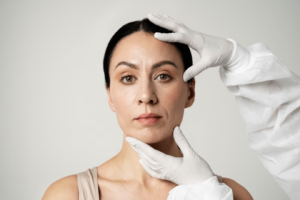Over 80% of adults have reported experiencing lower back pain at some point in their life. Back pain that lasts less than 6 weeks is considered acute, while pain that lasts longer than 12 weeks is chronic. Injury, aging and underlying diseases are all common causes of lower back pain.
At Greenberg Regenerative Medicine, we understand the day-to-day struggle when living with back pain. Our goal is to find the source of your pain and offer a personalized treatment plan designed for you. Our non-surgical and regenerative therapies are designed to help relieve your back pain.
Anatomy of the lower back
Lower back pain is one of the most common forms of musculoskeletal pain. Understanding the anatomy of the spine can help you better understand the causes of lower back pain.
The lower back is composed of 5 vertebrae in the lumbar spine. It also contains 4 muscle groups; extensors, flexors, lateral flexors, and rotators. The lower back is flexible to allow for the constant twisting and turning we do throughout the day. The muscle groups and the lumbar spine work together to maintain balance and support the weight of the upper body. This puts daily stress on the lumbar spine and contributes to natural wear and tear over time.
The Many Common Causes of Lower Back Pain
Injury to the lower back
Any injury to the back, whether traumatic or caused by overuse, can lead to lower back pain as can high-impact sports like football. A sports injury, motor vehicle accident or bad fall can all result in sprains, strains or fractures in the lower back.
Sprain: A back sprain relates to a torn ligament caused by overexertion or injury. Lifting something that is too heavy or falling may also lead to a sprain.
Strain: A strain occurs when a tendon or muscle is torn. This can happen from overstretching and overexertion.
Fracture: A back fracture occurs when one or more spinal vertebra breaks. A broken back can be the result of severe injury or an underlying condition like osteoporosis.
Intervertebral discs: Intervertebral discs are the discs between the vertebrae of your spine. They provide cushioning and support to your vertebrae. As we age, these discs naturally become worn down. This process is normal, but it may become uncomfortable and lead to pain.
Age-related causes of lower back pain
Osteoporosis: Osteoporosis is the thinning of bone density that makes it easier for bones to break. It occurs with age and is more common among women. Osteoporosis can lead to compression fractures in the spine and back pain.
Herniated discs: Usually a result of disc degeneration, a herniated disc is an intervertebral disk that is bulging out of the spine. When the herniated disc presses against nerves, it causes radiating pain called radiculopathy. Radiculopathy refers to a set of conditions that affect the nerves. It can result in weakness, numbness, or difficulty controlling affected muscles.
Diseases linked to lower back pain
Spinal stenosis: Spinal stenosis is the narrowing of the spinal column. Spinal stenosis may also cause radiculopathy. This can compress nerves and put pressure on the spinal cord.
Arthritis: Osteoarthritis and rheumatoid arthritis can cause inflammation and pain in the lower back. Spondylitis is another term for osteoarthritis of the spine.
Other causes of lower back pain:
Sacroiliac joint pain: Sacroiliitis is the inflammation of the sacroiliac joints, which sit between the lower spine and pelvis. It can lead to pain in the lower back and buttocks that radiates down into the legs.
Sciatica: Sciatica is back pain caused by an injury to the sciatic nerve, which runs from the lower back down each leg. People typically experience sciatica due to a pinched or compressed nerve.
Piriformis: The piriformis is a small muscle located within the buttock. It extends from the sciatic nerve to the femur and helps the thigh rotate from side to side. A piriformis muscle spasm places pressure on the sciatic nerve and may result in sciatica.
Pelvic tilt: Individuals with an abnormal pelvic tilt may be prone to back pain. Pelvic tilt contributes to posture, so if it is abnormal, then posture will be affected. Incorrect posture can lead to excess pressure on certain parts of the spine, leading to persistent back pain.
Since there are so many common causes of lower back pain, it can be difficult to properly diagnose the exact cause of an individual’s symptoms. It requires a skilled clinician, like Dr. Greenberg, to pinpoint the exact cause of back pain based on careful and precise examination.
If you are experiencing lower back pain, Greenberg Regenerative Medicine can help you find relief without surgery. Dr. Greenberg is an expert in regenerative and integrative treatments that can get you back to pain-free living.
At Greenberg Regenerative Medicine, our treatments go beyond masking the pain with unnecessary opioids and steroids. Oftentimes, our patients come to us after several unsuccessful treatments from other clinicians. Our approach works because our approach is different. We do more than treat pain; we focus on finding lasting relief through regenerative means. Our treatments include stem cell therapy, prolotherapy and PRP therapy.
To discover the right treatment for you, book a consultation with Greenberg Regenerative Medicine today by calling (833) 440-HEAL.




